Research
Dr. Trinetta's research interests include the minimization of foodborne illness risk and the investigation persistence and survival of pathogens through the entire food supply chain.
Current projects and Past Projects are shown below.
 |
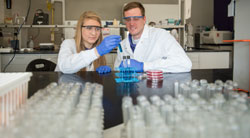 |
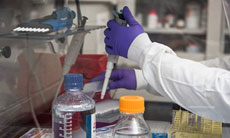 |
Current Projects
Modeling the Impact of Weather on Cleaning and Disinfection Strategies to Reduce Pathogen Risk in Swine Transport
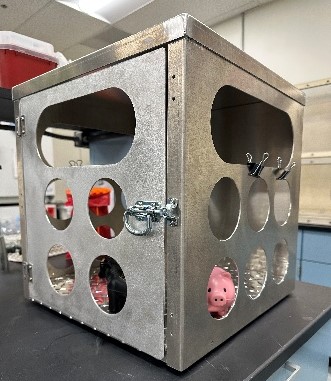 This study aims to enhance biosecurity in the swine industry by evaluating the effectiveness of cleaning and disinfection strategies for trucks and trailers used in swine transport. It investigates novel technologies to combat pathogens such as Escherichia coli, PEDV, and Rotavirus A under various environmental conditions. A risk assessment model will be developed to optimize disinfection protocols based on temperature and geographical factors, providing valuable insights to improve biosecurity and reduce contamination risks.
This study aims to enhance biosecurity in the swine industry by evaluating the effectiveness of cleaning and disinfection strategies for trucks and trailers used in swine transport. It investigates novel technologies to combat pathogens such as Escherichia coli, PEDV, and Rotavirus A under various environmental conditions. A risk assessment model will be developed to optimize disinfection protocols based on temperature and geographical factors, providing valuable insights to improve biosecurity and reduce contamination risks.
The study considers two bacterial attachment conditions: planktonic and mature biofilm. Planktonic conditions reflect facilities that frequently implement cleaning and sanitation, as bacteria remain attached to surfaces for shorter periods. In contrast, mature biofilm conditions simulate sporadic sanitation practices, offering insights into their impact on pathogen persistence.
Formation and Control of Single and Dual-Species Biofilms of Listeria monocytogenes and Pseudomonas fluorescens on Food Processing Surfaces
 Biofilms are complex microbial structures embedded in an extracellular polymeric substance. Once formed, they become difficult to remove and can persist in food processing environments, posing a risk of contamination. Listeria monocytogenes, a foodborne pathogen with a high fatality rate, can form biofilms both as a single species and in mixed-species communities. Therefore, this project aims to assess the growth of L. monocytogenes alone and in co-culture with Pseudomonas fluorescens on various surfaces representative of food processing facilities, as well as to evaluate the efficacy of sanitizers and ultraviolet light in biofilm removal. Understanding the impact of surface cleanability, topographical, and architectural characteristics on biofilm formation and removal is crucial for developing effective sanitizing strategies in food processing environments.
Biofilms are complex microbial structures embedded in an extracellular polymeric substance. Once formed, they become difficult to remove and can persist in food processing environments, posing a risk of contamination. Listeria monocytogenes, a foodborne pathogen with a high fatality rate, can form biofilms both as a single species and in mixed-species communities. Therefore, this project aims to assess the growth of L. monocytogenes alone and in co-culture with Pseudomonas fluorescens on various surfaces representative of food processing facilities, as well as to evaluate the efficacy of sanitizers and ultraviolet light in biofilm removal. Understanding the impact of surface cleanability, topographical, and architectural characteristics on biofilm formation and removal is crucial for developing effective sanitizing strategies in food processing environments.
Mapping microbial diversity and resistome in conventional and antibiotic-free chicken farming and its implications for one's health
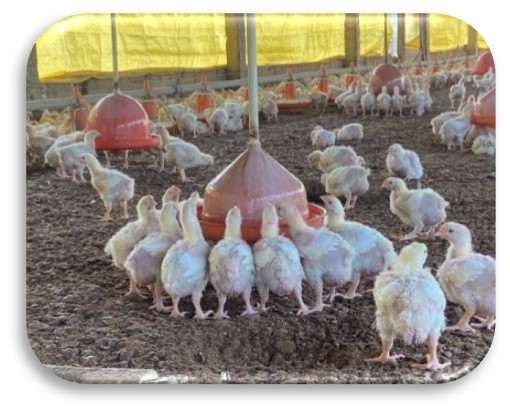 Antibiotic resistance is one of the greatest global public health concerns, and animal food production plays a significant role in the selective pressure on bacteria, particularly in the broiler chicken production chain. A comprehensive epidemiological assessment of antibiotic resistance in this sector requires a One Health approach. In this context, high-throughput DNA sequencing tools have become essential, allowing the identification of antibiotic resistance genes (ARGs) present in a sample (known as the resistome), as well as the detection of microorganisms and other functional genes. This information is crucial for making more effective decisions to mitigate this issue. Emanoelli conducts her PhD research by analyzing the phenotypic and genotypic characteristics of pathogens and environmental microorganisms throughout the food production system, from the beginning of the production chain to the final product.
Antibiotic resistance is one of the greatest global public health concerns, and animal food production plays a significant role in the selective pressure on bacteria, particularly in the broiler chicken production chain. A comprehensive epidemiological assessment of antibiotic resistance in this sector requires a One Health approach. In this context, high-throughput DNA sequencing tools have become essential, allowing the identification of antibiotic resistance genes (ARGs) present in a sample (known as the resistome), as well as the detection of microorganisms and other functional genes. This information is crucial for making more effective decisions to mitigate this issue. Emanoelli conducts her PhD research by analyzing the phenotypic and genotypic characteristics of pathogens and environmental microorganisms throughout the food production system, from the beginning of the production chain to the final product.
Novel Sorghum Applications
 Sorghum is widely cultivated around the world as a food and feed crop, but its nutritional benefits are often limited due to the presence of anti-nutritional factors, which interfere with protein and carbohydrate digestion, as well as mineral bioavailability. Controlled fermentation, particularly solid-state fermentation, offers a promising approach to enhance sorghum’s protein digestibility and functional properties. While fermented sorghum foods and beverages are commonly consumed in regions such as Asia and Africa, they remain underexplored in the United States.
Sorghum is widely cultivated around the world as a food and feed crop, but its nutritional benefits are often limited due to the presence of anti-nutritional factors, which interfere with protein and carbohydrate digestion, as well as mineral bioavailability. Controlled fermentation, particularly solid-state fermentation, offers a promising approach to enhance sorghum’s protein digestibility and functional properties. While fermented sorghum foods and beverages are commonly consumed in regions such as Asia and Africa, they remain underexplored in the United States.
This series of studies investigates the effects of sorghum fermentation on fermentation dynamics and functional properties across various product forms. Key areas of focus include microbial succession, taxonomic diversity, associated physical-chemical changes, metagenomic analysis, and chemical composition. Additionally, the research examines how solid-state fermentation of sorghum grains can further improve their nutritional quality and potential health benefits.
Enhancing Sorghum-Based Hummus with Nanoencapsulated Limonene-Thymol
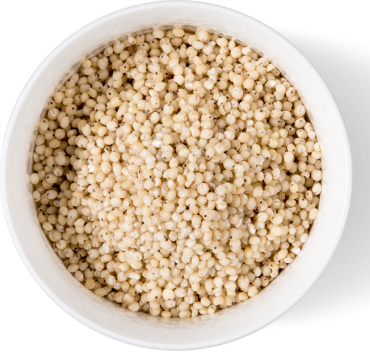 Sorghum, a nutrient-rich and gluten-free grain, has the potential to support food security in Saudi Arabia and beyond. Maddie’s research explores how nanoencapsulated GRAS (Generally Recognized as Safe) compounds—limonene and thymol—can improve the safety and shelf-life of sorghum-based hummus by controlling harmful pathogens like Staphylococcus, Listeria, and E. coli.
Sorghum, a nutrient-rich and gluten-free grain, has the potential to support food security in Saudi Arabia and beyond. Maddie’s research explores how nanoencapsulated GRAS (Generally Recognized as Safe) compounds—limonene and thymol—can improve the safety and shelf-life of sorghum-based hummus by controlling harmful pathogens like Staphylococcus, Listeria, and E. coli.
By understanding its microbiological stability, this research can influence public health policies, trade regulations, and market strategies, paving the way for a safer, more sustainable food option. Stay tuned for more updates!
The dolomite problem: a comparison between abiotic and biotic formation pathways
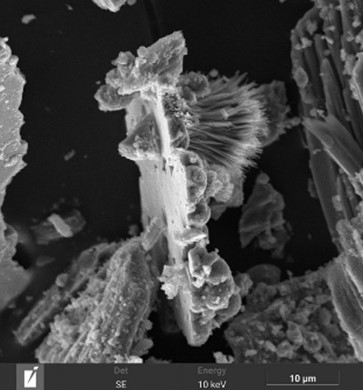 Dolomite is a very common mineral and a rock-forming mineral. In nature, it can be found in a wide variety of environments. It is a key component of ancient deposits, forming large masses of sedimentary rocks (dolomite and dolomitic limestones)geographically and hundreds to thousands of meters thick. Despite its widespread occurrence, dolomite is rarely found in recent sediments and appears to be unable to form at temperatures below 50 °C, even under supersaturated thermodynamic conditions. The phrase “dolomite problem” was introduced to describe a problem that has puzzled generations of scientists for more than 200 years, a unique and unparalleled problem in the natural sciences. Alice conducts her doctoral research by analyzing the factors can promote the formation of calcium and magnesium carbonates, evaluating both inorganic factors such as pH fluctuations, gas-phase interactions, ionic interactions and substrates, and organic factors such as the presence of organic molecules or organisms, paying particular attention to bacterial activity.
Dolomite is a very common mineral and a rock-forming mineral. In nature, it can be found in a wide variety of environments. It is a key component of ancient deposits, forming large masses of sedimentary rocks (dolomite and dolomitic limestones)geographically and hundreds to thousands of meters thick. Despite its widespread occurrence, dolomite is rarely found in recent sediments and appears to be unable to form at temperatures below 50 °C, even under supersaturated thermodynamic conditions. The phrase “dolomite problem” was introduced to describe a problem that has puzzled generations of scientists for more than 200 years, a unique and unparalleled problem in the natural sciences. Alice conducts her doctoral research by analyzing the factors can promote the formation of calcium and magnesium carbonates, evaluating both inorganic factors such as pH fluctuations, gas-phase interactions, ionic interactions and substrates, and organic factors such as the presence of organic molecules or organisms, paying particular attention to bacterial activity.
Some of the Past Projects
Controlling Biofilms on Food Contact Surfaces
Sanitation Strategies for Food Contact Surfaces Common in Fresh Food Markets in Cambodia
Sanitation Practices for Improved Food Safety at Farmers Markets
Improving the Safety of Cambodia's Vegetable Value Chain
Feed Safety and Salmonella Ecology
Improving the safety and quality of leafy greens
Survival of Salmonella in Animal Fat Intended for Pet Food Use
Understanding Listeria monocytogenes Biofilm
Investigation of the prevalence and distribution of Salmonella in feed mills
Antifungal packaging films to control postharvest diseases in strawberries
Biofilms on Food Contact Surfaces
Novel Sanitation Strategies to Control Listeria Biofilms in the Organic Produce Industry
Antimicrobial efficacy to TiO2 against Listeria, Salmonella, and E. coli in microgreen systems